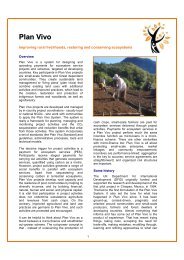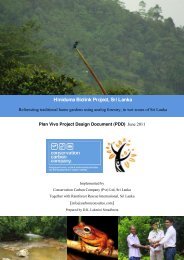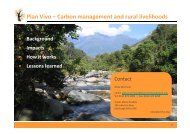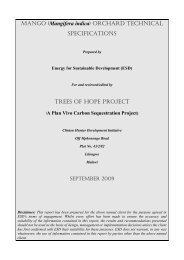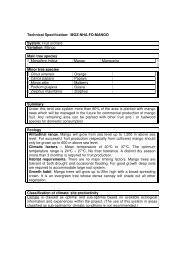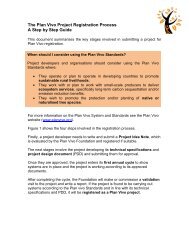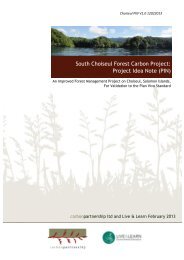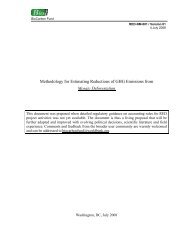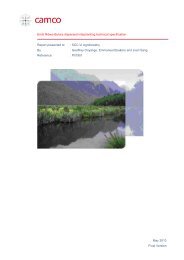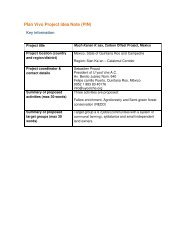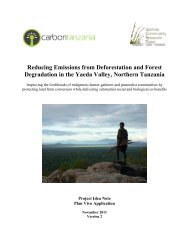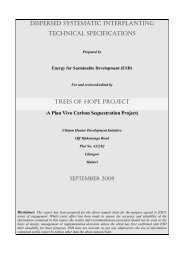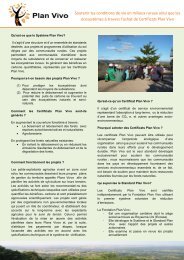Arbres locaux pour un monde meilleur | Local trees for a better world
Arbres locaux pour un monde meilleur | Local trees for a better world
Arbres locaux pour un monde meilleur | Local trees for a better world
Create successful ePaper yourself
Turn your PDF publications into a flip-book with our unique Google optimized e-Paper software.
14<br />
Comm<strong>un</strong>ity Payments <strong>for</strong> Ecosystem Services in Patako | Plan Vivo PDD 2012<br />
clears the land becomes the de facto land ‘owner’, and this is how land may come to be in the<br />
hands of a family of newcomers to an area. Fences may be used to demarcate land holdings. Tree<br />
products on privately owned land belong to the person, who plants the <strong>trees</strong>, provided they are<br />
the landowner. Guidance from the national level would appear to indicate that carbon<br />
sequestered by <strong>trees</strong> on private land also belongs to the landowner.<br />
To participate in the project, the landowner must demonstrate that he, she, or the group holds<br />
title to the land. Formal land title documents are provided by the rural co<strong>un</strong>cil.<br />
6.3. Socio-economic context and anticipated impacts<br />
Arlomom project activities are designed to protect the Classified Forest of Patako by improving the<br />
livelihoods of local people. Over time, the vegetation in the area is anticipated to develop through<br />
plan vivo activities which in turn, it is hoped, will reduce population pressure on riparian <strong>for</strong>est.<br />
6.4. Comm<strong>un</strong>ity-led design and livelihood benefits<br />
The Arlomom project has been developed through a participatory and inclusive approach. Through<br />
local meetings, local people have been involved in decision-‐making. They had decided which tree<br />
species to plant and have steered the design of the land management systems. The sharing<br />
sessions and awareness helped local people to get involved in making decisions and to be<br />
responsible <strong>for</strong> the selection of sites, participants, species and systems (agro<strong>for</strong>estry, bo<strong>un</strong>dary<br />
planting, plantations, and assisted natural regeneration). Participants chose native <strong>trees</strong> species<br />
taking into acco<strong>un</strong>t their livelihood needs, preferences, and concerns about the declining<br />
resources of the Patako Forest.<br />
The initial pilot sites and participants were selected based on a number of criteria; the<br />
comm<strong>un</strong>ities’ willingness to allocate land to women’s groups to have their own plan vivos, the<br />
motivation of the individuals to participate in the activities, the availability of land and water, and<br />
proximity to the Patako Forest.<br />
Continuing activities<br />
The Arlomom Association is responsible <strong>for</strong> project coordination. With support from the Forestry<br />
Department, Arlomom will provide assistance to local comm<strong>un</strong>ities, including organization,<br />
training, land tenure security, production of seedlings, and development of income-‐generating<br />
activities and the sharing of benefits from the PES.<br />
Monitoring and evaluation activities will be planted by the team in close collaboration with the<br />
Department of Water Affairs and Forestry. The support team will also focus on the management<br />
of the <strong>for</strong>est of Patako and development of NTFPs.




